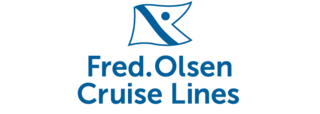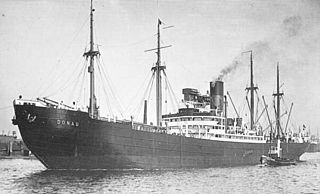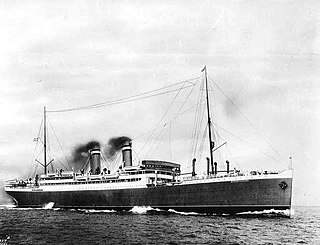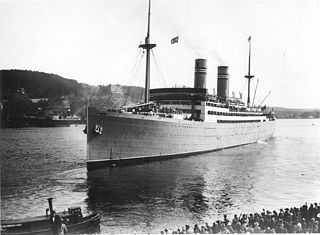Related Research Articles

The Oslofjord is an inlet in the south-east of Norway, stretching from an imaginary line between the Torbjørnskjær and Færder lighthouses and down to Langesund in the south to Oslo in the north. It is part of the Skagerrak strait, connecting the North Sea and the Kattegat sea area, which leads to the Baltic Sea. The Oslofjord is not a fjord in the geological sense — in Norwegian the term fjord can refer to a wide range of waterways. The bay is divided into the inner and outer Oslofjord at the point of the 17 by 1 kilometre Drøbak Sound.

Norwegian Cruise Line (NCL), also known in short as Norwegian, is a cruise line founded in 1966 and based in the United States. It is the third-largest cruise line in the world by passengers, controlling approximately 8.7% of the total worldwide share of the cruise market by passengers as of 2018. It is wholly owned by parent company Norwegian Cruise Line Holdings.

The Norwegian America Line, was a cruise ship line, originally an operator of passenger and cargo ships. Founded in 1910, the company ran a regular transatlantic service between Norway and the United States, and later included a route to East Africa as well. Primarily due to competition from air travel, transatlantic passenger voyages were slowly discontinued during the years.

Fred. Olsen Cruise Lines is a UK-based, Norwegian-owned cruise shipping line with four cruise ships. The company is owned by Bonheur and Ganger Rolf and is headquartered in Ipswich, Suffolk, in the United Kingdom. The company is part of the Fred. Olsen Group.

MS Saga Ruby was a cruise ship that was last operated by Saga Cruises. She was built as the combined ocean liner/cruise ship Vistafjord in 1973 by Swan Hunter Shipbuilders in the United Kingdom for the Norwegian America Line. In 1983 she was sold to Cunard Line, retaining her original name until 1999 when she was renamed Caronia. In 2004 she was sold to Saga and sailed as Saga Ruby until sold in 2014 for use as a floating hotel and renamed Oasia. This never came to fruition. Her owners went bankrupt, and in April 2017 she arrived at Alang for scrapping.

SS Kristianiafjord was the first ship in the fleet of the Norwegian America Line, built by Cammell Laird in Birkenhead, UK. The name refers to the fjord leading into the Norwegian capital Oslo, at the time called Kristiania. Launched from its shipyard on 23 November 1912, it was put into service in 1913, the same year as its sister ship, SS Bergensfjord. It embarked on its maiden voyage on 4 June that year, sailing from Christiania (Oslo) through Christiansand, Stavanger and Bergen to New York, with the captain S. C. Hiortdahl. Kristianiafjord had a tonnage of 10,699, and was fitted with wireless and electric light. She could take 1,200 passengers – 100 first class, 250 second class and 850 third class.
SS Dwinsk was a British-flagged ocean liner sunk by SM U-151 in World War I. The ship was previously the third Rotterdam for the Holland America Line, C.F. Tietgen for the Scandinavian America Line, and, as Dwinsk, for the Russian American Line. The ship was put under Cunard Line management in 1917, and sailed under the British flag until sunk on 18 June 1918.

SS Donau was a Norddeutscher Lloyd refrigerated cargo ship. In the Second World War the Kriegsmarine used it as a transport ship between Germany and Norway. She became known as the "slave ship" after the SS and Gestapo transported 540 Jews from Norway to Stettin, from where they were taken by train to Auschwitz. Only nine of those deported on the Donau survived.

SS Potsdam was an ocean liner built in 1900 by the Blohm + Voss shipyard in Hamburg, Germany for the Holland America Line (HAL) for transatlantic service from Rotterdam to New York. She was the largest ship operated by HAL at the time.

MS Oslofjord was a combined ocean liner/cruise ship built in 1949 by Netherlands Shipbuilding Company in Amsterdam, Netherlands for Norwegian America Line. As built she was 16,844 gross register tons, and could carry 620 passengers.

MS Oslofjord was an ocean liner built in 1938 by A/G Weser Shipbuilders, Bremen, Germany for Norwegian America Line. She was 18,673 gross register tons, and could carry 860 passengers. She sank on 21/22 January 1941 after hitting a mine off the River Tyne on 1 December 1940, after just two years of service. She sits in 15m at 55°0.17′N1°23.72′W.
Oslofjord is the fjord leading up to Oslo, Norway.

SS Prinz Friedrich Wilhelm was an ocean liner for North German Lloyd (NDL) from her launch in 1907 until the end of World War I. After the war, she briefly served as USS Prinz Friedrich Wilhelm (ID-4063) for the United States Navy returning American troops from France. The vessel was first chartered—and later purchased outright—by Canadian Pacific Steamships (CP) and operated under the names Empress of China, Empress of India, Montlaurier, Monteith, and Montnairn. She was scrapped in 1929.
SS Statendam was a 10,322 ton (gross) ship of the Holland America Line, built by Harland and Wolff, launched in 1898 and completed on 18 August 1898. She was sold to the Allan Line in 1911 and renamed SS Scotian. The Allan Line was taken over in 1917 by Canadian Pacific Line, who continued to operate her as the Scotian until 1922, when she was renamed SS Marglen. She was scrapped in 1927.

SS Bergensfjord was a Norwegian ocean liner that sailed for the Norwegian America Line to the United States. During the Second World War she was requisitioned by the British Ministry of War Transport and used as a troop ship. After the war she continued sailing as a Trans-Atlantic passenger liner, first for South American owners, then for an Israeli company.
SS Doric was a British ocean liner operated by White Star Line.
SS Ionic was a cargo liner initially in service with White Star Line from 1883 until 1900. She was used on the company's joint route to New Zealand with the Shaw, Savill & Albion Line. She was sold to the Aberdeen Line in 1900 and renamed SS Sophocles, and was withdrawn for service in 1906 and scrapped in 1908.
Several steamships have borne the name Donau, after the German name for the river Danube:

SS Haverford was an American transatlantic liner commissioned in 1901 for the American Line. During World War One, Haverford was utilized as a troop transport vessel in the North Atlantic Ocean. Following the war, the White Star Line purchased and recommissioned the ship. She was decommissioned in 1924 and scrapped in 1925.

SS Stavangerfjord was a Norwegian ocean liner that sailed for the Norwegian America Line between Norway and the United States and sailed periodically to Canada. She was the third ship of the Norwegian American Line, and similar to the company's first two ships. SS Stavangerfjord was built by Cammell Laird in Birkenhead, England. The ship was launched on May 21, 1917, and was put into service in April 1918. The ship sailed to New York and due to World War I, it did not arrive in Bergen until September 21, 1918. In 1924 her fuel was converted from coal to oil combustion.
References
- ↑ "M/V Oslofjord (1), NAL - The Norwegian-America Line". Norway-Heritage. Retrieved 2008-01-10.
- "Norwegian America Line". The Fleets. The Ships List. Archived from the original on 2008-03-03. Retrieved 2013-08-31.